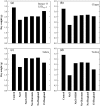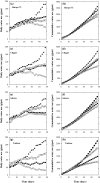Additive effects of Na+ and Cl- ions on barley growth under salinity stress
- PMID: 21273334
- PMCID: PMC3060698
- DOI: 10.1093/jxb/erq422
Additive effects of Na+ and Cl- ions on barley growth under salinity stress
Abstract
Soil salinity affects large areas of the world's cultivated land, causing significant reductions in crop yield. Despite the fact that most plants accumulate both sodium (Na(+)) and chloride (Cl(-)) ions in high concentrations in their shoot tissues when grown in saline soils, most research on salt tolerance in annual plants has focused on the toxic effects of Na(+) accumulation. It has previously been suggested that Cl(-) toxicity may also be an important cause of growth reduction in barley plants. Here, the extent to which specific ion toxicities of Na(+) and Cl(-) reduce the growth of barley grown in saline soils is shown under varying salinity treatments using four barley genotypes differing in their salt tolerance in solution and soil-based systems. High Na(+), Cl(-), and NaCl separately reduced the growth of barley, however, the reductions in growth and photosynthesis were greatest under NaCl stress and were mainly additive of the effects of Na(+) and Cl(-) stress. The results demonstrated that Na(+) and Cl(-) exclusion among barley genotypes are independent mechanisms and different genotypes expressed different combinations of the two mechanisms. High concentrations of Na(+) reduced K(+) and Ca(2+) uptake and reduced photosynthesis mainly by reducing stomatal conductance. By comparison, high Cl(-) concentration reduced photosynthetic capacity due to non-stomatal effects: there was chlorophyll degradation, and a reduction in the actual quantum yield of PSII electron transport which was associated with both photochemical quenching and the efficiency of excitation energy capture. The results also showed that there are fundamental differences in salinity responses between soil and solution culture, and that the importance of the different mechanisms of salt damage varies according to the system under which the plants were grown.
Figures



Similar articles
-
High concentrations of Na+ and Cl- ions in soil solution have simultaneous detrimental effects on growth of faba bean under salinity stress.J Exp Bot. 2010 Oct;61(15):4449-59. doi: 10.1093/jxb/erq251. Epub 2010 Aug 16. J Exp Bot. 2010. PMID: 20713463 Free PMC article.
-
Differences in efficient metabolite management and nutrient metabolic regulation between wild and cultivated barley grown at high salinity.Plant Biol (Stuttg). 2010 Jul 1;12(4):650-8. doi: 10.1111/j.1438-8677.2009.00265.x. Plant Biol (Stuttg). 2010. PMID: 20636908
-
Discerning morpho-anatomical, physiological and molecular multiformity in cultivated and wild genotypes of lentil with reconciliation to salinity stress.PLoS One. 2017 May 25;12(5):e0177465. doi: 10.1371/journal.pone.0177465. eCollection 2017. PLoS One. 2017. PMID: 28542267 Free PMC article.
-
Sodium chloride toxicity and the cellular basis of salt tolerance in halophytes.Ann Bot. 2015 Feb;115(3):419-31. doi: 10.1093/aob/mcu217. Epub 2014 Dec 1. Ann Bot. 2015. PMID: 25466549 Free PMC article. Review.
-
Salinity tolerance in barley during germination- homologs and potential genes.J Zhejiang Univ Sci B. 2020 Feb.;21(2):93-121. doi: 10.1631/jzus.B1900400. Epub 2020 Feb 5. J Zhejiang Univ Sci B. 2020. PMID: 32115909 Free PMC article. Review.
Cited by
-
Alternative splicing responses to salt stress in Glycyrrhiza uralensis revealed by global profiling of transcriptome RNA-seq datasets.Front Genet. 2024 Jul 9;15:1397502. doi: 10.3389/fgene.2024.1397502. eCollection 2024. Front Genet. 2024. PMID: 39045328 Free PMC article.
-
Physiological responses of Kosteletzkya virginica to coastal wetland soil.ScientificWorldJournal. 2015;2015:354581. doi: 10.1155/2015/354581. Epub 2015 Mar 11. ScientificWorldJournal. 2015. PMID: 25853144 Free PMC article.
-
Poultry biogas slurry can partially substitute for mineral fertilizers in hydroponic lettuce production.Environ Sci Pollut Res Int. 2019 Jan;26(1):659-671. doi: 10.1007/s11356-018-3538-1. Epub 2018 Nov 9. Environ Sci Pollut Res Int. 2019. PMID: 30414022
-
Setting a Plausible Route for Saline Soil-Based Crop Cultivations by Application of Beneficial Halophyte-Associated Bacteria: A Review.Microorganisms. 2022 Mar 19;10(3):657. doi: 10.3390/microorganisms10030657. Microorganisms. 2022. PMID: 35336232 Free PMC article. Review.
-
Scrutinizing the Application of Saline Endophyte to Enhance Salt Tolerance in Rice and Maize Plants.Front Plant Sci. 2022 Feb 17;12:770084. doi: 10.3389/fpls.2021.770084. eCollection 2021. Front Plant Sci. 2022. PMID: 35251059 Free PMC article.
References
-
- Amtmann A, Sanders D. Mechanisms of Na uptake by plant cells. Advances in Botanical Research. 1998;29:75–112.
-
- Apse MP, Blumwald E. Na+ transport in plants. FEBS Letters. 2007;581:2247–2254. - PubMed
-
- Aydi S, Sassi S, Abdelly C. Growth, nitrogen fixation and ion distribution in Medicago truncatula subjected to salt stress. Plant and Soil. 2008;312:59–67.
-
- Ball MC, Chow WS, Anderson JM. Salinity-induced potassium deficiency causes loss of functional photosystem II in leaves of the grey mangrove, Avicennia marina, through depletion of the atrazine-binding polypeptide. Australian Journal of Plant Physiology. 1987;14:351–361.
-
- Boursier P, Läuchli A. Mechanisms of chloride partitioning in the leaves of salt-stressed Sorghum bicolor L. Physiologia Plantarum. 1989;77:537–544.
Publication types
MeSH terms
Substances
LinkOut - more resources
Full Text Sources
Miscellaneous

